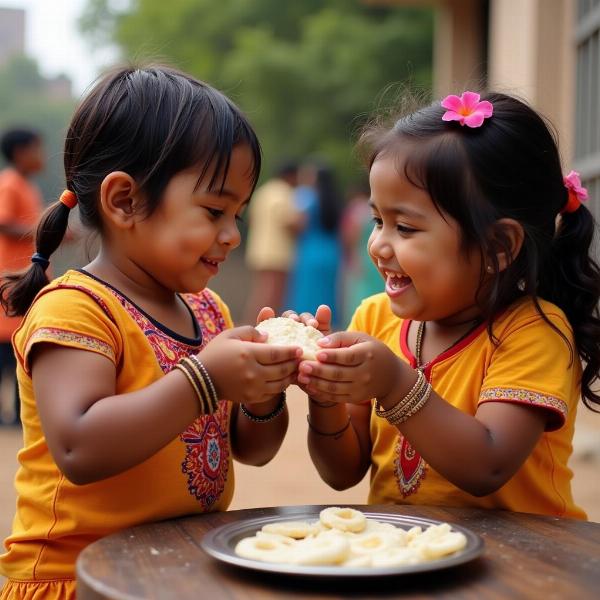Understanding the nuances of politeness and kindness in a different language can be challenging. When looking for the “be nice meaning in Hindi,” you’ll find it’s not just about a single word, but a spectrum of expressions reflecting the rich cultural context of India. This article explores the various ways to convey “be nice” in Hindi, delving into the cultural significance of these expressions and offering practical examples.
Exploring “Be Nice” in Hindi: Beyond Direct Translations
While there’s no single perfect translation for “be nice” in Hindi, several phrases capture the essence of kindness and politeness. These include “achchhe se pesh aana” (अच्छे से पेश आना), meaning to behave well, and “vinamr raho” (विनम्र रहो), which translates to “be humble” or “be polite.” The best choice depends on the specific context. For instance, advising a child might involve “achchhe bacche bano” (अच्छे बच्चे बनो) meaning “be a good child,” while interacting with elders would call for more respectful phrasing like “kripya karke” (कृपया करके) or “daya karke” (दया करके), which translate to “please.”
 Children showing kindness in India
Children showing kindness in India
The Cultural Significance of Niceness in India
Indian culture places a strong emphasis on respect, especially towards elders and those in positions of authority. This respect is often expressed through specific language and gestures. “Namaste” (नमस्ते), for example, is a common greeting that conveys respect and humility. Offering food and drinks to guests is also a customary way of showing kindness and hospitality. These cultural nuances demonstrate that “being nice” goes beyond mere words and encompasses a holistic approach to interactions.
“Be Nice” in Different Situations: Practical Examples
Using the correct phrase for “be nice” can significantly enhance your communication in Hindi. Here are some examples of how to use these expressions in different scenarios:
- To a child: “Achchhe bacche bano aur apne bade bhaiya/didi ki baat mano” (अच्छे बच्चे बनो और अपने बड़े भैया/दीदी की बात मानो) – Be a good child and listen to your older brother/sister.
- To a friend: “Thoda achchhe se pesh aa yaar” (थोड़ा अच्छे से पेश आ यार) – Behave a little better, friend.
- To an elder: “Kripya karke baithiye” (कृपया करके बैठिए) – Please sit down.
- In a formal setting: “Maaf kijiyega” (माफ़ कीजिएगा) – Excuse me.
Be Polite and Respectful: More Ways to “Be Nice”
Beyond the phrases mentioned above, several other expressions convey politeness and respect in Hindi. Using “ji” (जी) after someone’s name is a common way to show respect. For example, addressing someone as “Ram ji” (राम जी) instead of just “Ram” (राम) adds a layer of politeness. Similarly, using honorifics like “aap” (आप) for “you” (formal) instead of “tum” (तुम) (informal) is essential for demonstrating respect, particularly when interacting with elders or strangers. nice moment meaning in hindi
Be Kind and Considerate: Actions Speak Louder than Words
“Being nice” in Hindi, just as in any language, extends beyond mere words. Actions that demonstrate kindness, such as helping someone in need, offering a seat on public transport, or simply listening attentively, are highly valued. These acts of kindness often resonate more deeply than words, reinforcing the importance of genuine consideration in Indian culture. beautiful view meaning in hindi
Conclusion: Embracing the Spirit of “Be Nice” in Hindi
Learning how to “be nice” in Hindi requires understanding the cultural context and nuances of the language. By incorporating the appropriate phrases and demonstrating genuine kindness and respect, you can build stronger relationships and navigate social situations with greater ease. Remember, being nice is not just about saying the right words; it’s about embodying the spirit of kindness and respect in your interactions.
FAQ:
-
What is the most common way to say “be nice” in Hindi? While a direct translation doesn’t exist, “achchhe se pesh aana” (अच्छे से पेश आना) is a versatile phrase that conveys the general meaning.
-
How do I show respect to elders in Hindi? Use respectful language like “kripya karke” (कृपया करके) for “please” and address them with “ji” after their name.
-
Is “Namaste” a way of being nice? Yes, “Namaste” (नमस्ते) is a respectful greeting that conveys politeness and humility.
-
What are some other ways to be nice beyond words? Offering help, showing hospitality, and listening attentively are all considered acts of kindness.
-
Why is it important to understand the cultural context of “be nice” in Hindi? Cultural nuances play a significant role in communication. Understanding these nuances ensures your message is conveyed respectfully and effectively.
-
Is there a difference between “aap” (आप) and “tum” (तुम) when saying “be nice”? Yes, “aap” (आप) is the formal and respectful way to say “you,” while “tum” (तुम) is informal and should be used only with close friends and family.
-
How can learning how to “be nice” in Hindi benefit me? It helps build stronger relationships, enhances communication, and allows you to navigate social situations effectively. benignant meaning in hindi
Related Articles:
Meaning-Hindi.in is your one-stop solution for all your Hindi translation needs. We specialize in various translation services, from business and legal documents to technical manuals and website localization. Our expert team ensures accurate and culturally sensitive translations, bridging the language gap for individuals and businesses alike. Need professional Hindi translation services? Contact us today at [email protected] or call us at +91 11-4502-7584. Meaning-Hindi.in offers high-quality, culturally sensitive translations to help you connect with your Indian audience.